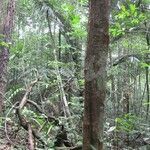Tree 3-15 m tall, young stems ferruginous-hirsute-tomentose. Leaves paripinnate or imparipinnate; petiole plus rachis 9-30 cm long, hirsute; petiolules 1-3 mm long, hirsute; leaflets (3) 6-10, alternate or less often opposite, chartaceous, the adaxial surface glabrous, with puberulent midvein, the abaxial surface sparsely hirsute, especially along the prominent venation, oblanceolate, elliptic or oblong, 6-18 × 3.5-6.5 cm, the apex acute, acuminate, or apiculate, the base slightly to strongly asymmetrical, cuneate to obtuse, the margins straight or slightly revolute, serrate, with mucronate teeth. Thyrses 5-20 cm long, paniculate, tomentose; dichasia simple or compound; bracteoles lineate, 2.5-3 mm long. Sepals hirsute, elliptic, 1.2-2 mm long; petals unguiculate, elliptic, 2.5-2.7 mm long, glabrous except for the pubescent claw; appendages of two suprabasal, marginal projections, wooly-pubescent, as long as the petal; disc annular, glabrous; stamens 8, ca. 4 mm long, the filaments wooly at base. Capsules turbinate-trilobed to tricoccate, reddish orange, 3-locular, the cocci short to elongated and divergent, 0.5-1.5 cm long; pericarp ca. 2 mm thick, outer surface ferruginous, hirsute, tomentose-hirsute or sparsely hirsute, inner surface densely creamish wooly, the stipe 3-4 mm long. Seeds nearly rounded, black or blackish brown, with a cream fleshy aril on lower half.
More
Trees to 12 m tall; stems sulcate, densely hirsute-tomentose when young, glabrescent. Leaves pinnate; leaflets 6-12, *nearly sessile or with a petiolule to 3 mm long, elliptic-oblong to obovate-oblanceolate, acuminate at the apex, acute to attenuate at the base, 4-20(-28) cm long, 2.2-7(-11) cm wide, glabrous on the upper surface except hirsute on the major veins, hirsute throughout below, espe-cially on the veins, the surface shiny, the margin serrate-dentate in the outer 2/3. Inflorescences terminal or upper axillary panicles to ca. 20 cm long, the branches, pedicels and calyces rufous-tomentose; bracteoles subulate, to 2 mm long; pedicels 1-1.5 mm long. Flowers white; sepals ovate-oblong, 2-3 mm long; petals obovate, to 2 mm long, glabrous on the outer surface except on the short claw, the scale fused to the lateral margin on the inner surface in the lower half, densely villous; bisexual flowers with the stamens 2.5-3 mm long, the filaments villous in the lower /3, the disc glabrous. Capsules turbinate-trilobed, subtricornute, ca. 1.5 cm long, reddish brown hirsute both inside and outside; seeds ellipsoid.


